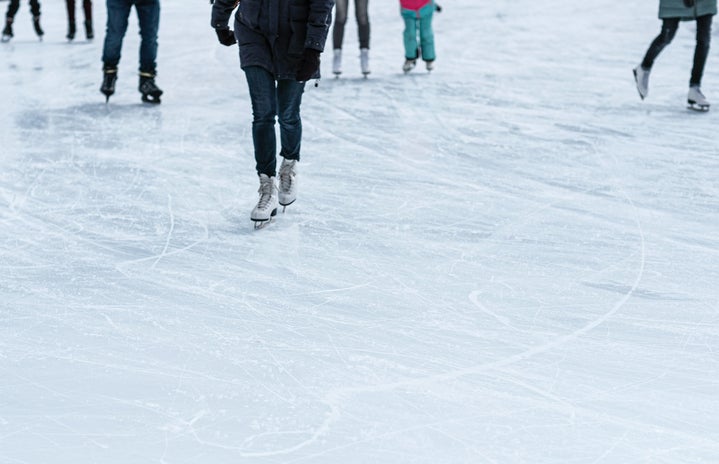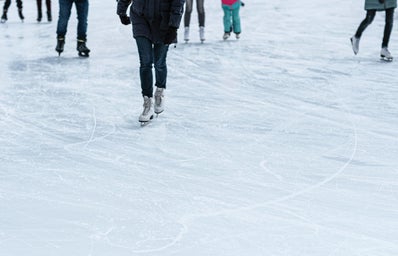If you’re anything like me, then you only watch figure skating once every four years—during the Olympics, when skaters from across the world take to the ice in a dazzling display of skill, athleticism and artistry. There is something incredibly spectacular about someone making a sport look so easy, and it seems as though new and younger skaters are pushing the sport farther than ever. For example, the first quadruple jump successfully landed in competition (that’s when skaters complete four rotations in the air!) was in 1988 by Canadian skater Kurt Browning. America’s Nathan Chen landed five quad jumps in his gold-medal winning skate. The first woman to land a quad jump was Japan’s Miki Ando in 2002; however, the first woman to land that jump in an Olympic competition was 15-year-old Russian skater Kamila Valiyeva in Beijing. That is an amazing feat in a short amount of time in comparison to other sports.
The quad jump has become, in recent years, a hallmark of skating. A skater’s chances of making it the Olympics are often contingent upon their ability to do quad jumps. For the men, it is often a question of how many quads can be successfully landed in a program. For the women, a quad jump sets a skater apart from the rest in a powerful way. To do four rotations in the air, skaters need to jump as high as possible, maximizing their spinning time and giving them enough distance to successfully land on one leg. It is important to have both strength and speed when going into a quad jump. However, in this new age of quads in women’s skating, there is also an emphasis on body size and figure—skaters with narrower frames and more petite builds can spring themselves higher in the air, making tighter and tighter rotations. Being small can be a serious advantage in jumping quads, and since quad jumps and attempts are rewarded with more points than triples (even if a skater falls), there is a new pressure for women to try the jump.
Many people feel that the pressure to do these jumps could push young women to maintain unhealthy body weights, and indeed many young female skaters often view puberty as a threat to their skating abilities. After puberty, skaters must relearn how to jump given their new size and centers of gravity, and therefore there is a major question of whether these jumps should be as rewarded as they are given the way that younger, slimmer skaters seem to be the only ones who benefit from the current system. For instance, Alysa Liu, the first American skater to land a quad jump in a competition, has not performed the jump since she had a growth spurt. The impact of landing quads can be detrimental on the body, and if skaters do not prioritize technique and safety to minimize injury, there could be serious future repercussions.
If you’ve been watching the games so far, then you might have noticed that there has been a fair bit of drama surrounding the quad jumps and the Russian girl who made history for landing it. Russian figure skater Kamila Valieva, coached by the legendary Eteri Tutberidze, who has led several young women to their Olympic gold dreams, made history when she landed two quads in the team competition. Tutberidze’s skaters—young, talented and stunning on the ice—have historically experienced incredible wins and national accolade before suffering injury and retiring, all before their 20th birthdays. The girls who skate for Tutberidze dominate at the Olympics, even going so far as to win gold, and then are dropped in favor of younger, newer skaters.
Yulia Lipnitskaya won gold for Russia in Sochi in 2014, when she was only 15 years old, the youngest woman to win a gold medal at the Olympics. She would retire from the sport only three years later due to injuries and her struggle with an eating disorder. While other athletes would be at the top of their careers at that young age, she was already too old for a sport that has begun to favor younger, smaller girls who can jump high and do not yet have the autonomy and freedom of adulthood. Alina Zagitova and Evgenia Medvedeva, who won gold and silver for Russia in the 2018 Olympics, did not make the national team for the 2021-22 season. Zagitova is only 19 and is already out of the spotlight, despite winning gold at the Olympics only four years ago.
The drama escalated last week when 15-year-old Kamila Valieva tested positive for doping, news that cast a shadow on her gold medal at the team event. The skater tested positive for trimetazidine, a drug that is typically prescribed for older patients with angina and other heart conditions. The medication, which is meant to help patients who suffer from chest pain, works by metabolizing fatty acids, thereby helping the body to use oxygen, which can improve sport performance. The drug itself was added to the World Anti-Doping Agency’s list of banned substances in 2014. It is not recommended for individuals under the age of 18. This is not the first time that athletes have used the drug at the Olympics—Nadezhda Sergeeva, a Russian bobsledder, also tested positive for the drug and was disqualified from the games in Pyeongchang, South Korea.
While Valieva sent in her sample to the labs in December, the news of her positive test was not announced until after she had stunned the crowd into first place, leaving many people speechless over her impressive quad jumps. The International Testing Agency reported her positive test results, and the news immediately shocked the figure skating world. She was suspended from competing in the individual event. The team medal ceremony, in which Russia would receive gold, was delayed until a decision could be made. Shockingly, she was able to appeal the decision and she was allowed to compete in the women’s individual event, to the outrage of many fans of the sport. Her lawyer claimed that she had unknowingly ingested the drug, which had belonged to her grandfather. Skeptics feel that it would be difficult to unknowingly ingest, as it is a pill taken orally. Regardless, the decision by the Court of Arbitration for Sport has led to an uproar of opinion over whether she should be allowed to compete and who is at fault in the situation.
Some felt that she should not be allowed to compete—that rules are rules and there are no exceptions for doping. Many feel the hypocrisy of the situation given what happened at the summer Tokyo Olympics with Sha’Carri Richardson, an athlete who was prohibited from competing due to a positive drug test for marijuana. Richardson, like Valieva, was a promised athlete expected to do well in the competitions. THC, the active ingredient in marijuana, is on the World Anti-Doping Agency’s list of banned substances along with trimetazidine. However, while trimetazidine is believed to boost an athlete’s performance by aiding the heart, THC is not a performance-enhancing drug.
Some felt that Valieva, as a minor, did not have full autonomy in her decision to take the drug, and therefore the responsibility of the doping scandal should fall on her coaches rather than punish her. The Court of Arbitration for Sport made the following statement in its report on the situation, saying that “None of this is the fault of the athlete, and it has put her in a remarkably difficult position where she faces a lifetime of work being taken from her within days of the biggest event of her short career.”
While the situation is far from cleared, many fans of the sport feel that the decision to let Valieva skate will forever change the future of figure skating, and quite possibly in detrimental ways. Some feel that the age limit to compete at the senior level should be increased to promote longevity in the sport. They feel that by allowing young skaters to compete at this level, there is a greater risk of injury to the self and the athletes themselves have less autonomy over their careers and bodies.
Valieva did skate in the individual competitions, and under the scrutiny of the Olympic crowd and the expectations of her coach, she performed poorly, completely missing the podium. Her Russian teammates, Anna Shcherbakova and Alexandra Trusova, both 17 years old, secured gold and silver. There were no smiles afterwards. Upon leaving the ice, Kamila Velieva, the young girl who was expected to win gold and was proclaimed the “best skater in the world,” was hounded by her coach, questioned as to why she had “stopped fighting.” Shcherbakova, the gold medalist, would later say in an interview that she “was feeling a lot of pleasure because I happened to be in the right time and the right place and did the right things… On the other hand, I feel this emptiness inside.” The silver medalist, Trusova, was noted as saying that she didn’t “want to do anything in figure skating ever in my life.” What was meant to be a day of excitement and dreams realized had turned into a nightmare. In the waning smoke of the night one question remained—“What needs to change?” The system, as it stands, does not protect its athletes, but instead capitalizes on the abilities of youth with no regard for long-term physical and emotional health. Figure skating, with its spins and twirls, has always been dramatic, but never quite like this.


